"BioCoder" entries

BioCoder strikes again
New issue: bioreactors and food production, modeling a worm's brain on a computer and letting it drive a robot, and more.
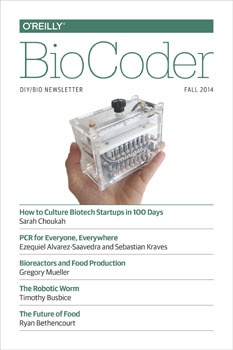 The fifth issue of BioCoder is here! We’ve made it into our second year: this revolution is in full swing.
The fifth issue of BioCoder is here! We’ve made it into our second year: this revolution is in full swing.
Rather than talk about how great this issue is (though it is great), I’d like to ask a couple of questions. Post your answers in the comments; we won’t necessarily reply, but we will will read them and take them into account.
- We are always interested in new content, and we’ll take a look at almost anything you send to BioCoder@oreilly.com. In particular, we’d like to get more content from the many biohacker labs, incubators, etc. We know there’s a lot of amazing experimentation out there. But we don’t know what it is; we only see the proverbial tip of the iceberg. What’s the best way to find out what’s going on?
- While we’ve started BioCoder as a quarterly newsletter, that’s a format that already feels a bit stodgy. Would you be better served if BioCoder went web-native? Rather than publishing eight or 10 articles every three months, we’d publish three or four articles a month online. Would that be more useful? Or do you like things the way they are?
And yes, we do have a great issue, with articles about a low-cost MiniPCR, bioreactors and food production, and what happens when you model a worm’s brain on a computer and let it drive a robot. Plus, an interview with Kyle Taylor of the glowing plant project, the next installment in a series on lab safety, and much more. Read more…

Looking for the next generation of biocoders
Natalie Kuldell on the hard work of bringing biocoding to the classroom.
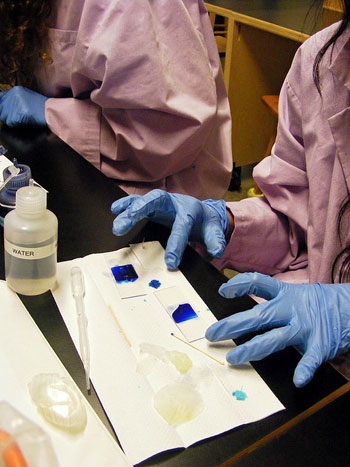 Synthetic biology is poised to change everything from energy development to food production to medicine — but there’s a bottleneck looming. How fast things develop depends on the number of people developing things. Let’s face it: there aren’t that many biocoders. Not in the universities, not in industry, not in the DIY sector. Not enough to change the world, at any rate. We have to ramp up.
Synthetic biology is poised to change everything from energy development to food production to medicine — but there’s a bottleneck looming. How fast things develop depends on the number of people developing things. Let’s face it: there aren’t that many biocoders. Not in the universities, not in industry, not in the DIY sector. Not enough to change the world, at any rate. We have to ramp up.
And that means we first must train teachers and define biocoding curricula. Not at the university level — try secondary, maybe even primary schools. That, of course, is a challenge. To get kids interested in synthetic biology, we have to do just that: get them interested. More to the point, get them jacked. Biocoding is incredibly exciting stuff, but that message isn’t getting across.
“Students think science and engineering is removed from daily life,” says Natalie Kuldell, an instructor of biological engineering at MIT. “We have to get them engaged, and connected to science and engineering — more specifically, bioengineering — in meaningful ways.”

Synthetic biology on the cusp
Oliver Medvedik on the grassroots future of biohacking and the problems with government overreach.
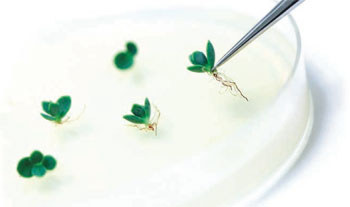 Whither thou goest, synthetic biology? First, let’s put aside the dystopian scenarios of nasty modified viruses escaping from the fermentor Junior has jury-rigged in his bedroom lab. Designing virulent microbes is well beyond the expertise and budgets of homegrown biocoders.
Whither thou goest, synthetic biology? First, let’s put aside the dystopian scenarios of nasty modified viruses escaping from the fermentor Junior has jury-rigged in his bedroom lab. Designing virulent microbes is well beyond the expertise and budgets of homegrown biocoders.
“Moreover, it’s extremely difficult to ‘improve’ on the lethality of nature,” says Oliver Medvedik, a visiting assistant professor at The Cooper Union for the Advancement of Science and Art and the assistant director of the Maurice Kanbar Center for Biomedical Engineering. “The pathogens that already exist are more legitimate cause for worry.” Read more…

Designing real vegan cheese
Synthetic biology surely can get weirder — but this is a great start.
I don’t think I will ever get tired of quoting Drew Endy’s “keep synthetic biology weird.” One of my favorite articles in the new issue of Biocoder is on the Real Vegan Cheese project.
If you’ve ever tried any of the various vegan cheese substitutes, they are (to put it kindly) awful. The missing ingredient in these products is the milk proteins, or caseins. And of course you can’t use real milk proteins in a vegan product.
But proteins are just organic compounds that are produced, in abundance, by any living cell. And synthetic biology is about engineering cell DNA to produce whatever proteins we want. That’s the central idea behind the Real Vegan Cheese project: can we design yeast to produce the caseins we need for cheese, without involving any animals? There’s no reason we can’t. Once we have the milk proteins, we can use traditional processes to make the cheese. No cows (or sheep, or goats) involved, just genetically modified yeast. And you never eat the yeast; they stay behind at the brewery.

Open source biology
Joe Schloendorn is creating and distributing plasmids that can freely be reproduced — a huge breakthrough for DIY bio.
At O’Reilly, we’ve long been supporters of the open source movement — perhaps not with the religious fervor of some, but with a deep appreciation for how open source has transformed the computing industry over the last three decades.
We also have a deep appreciation for the dangers that closed source, restrictive licenses, patent trolling, and other technocratic evils pose to areas that are just opening up — biology, in particular. So it is with great interest that I read Open Source Biotech Consumables in the latest issue of BioCoder.
I’m not going to rehash the article; you should read it yourself. The basic argument is that some proteins used in research cost thousands of dollars per milligram. They’re easily reproducible (we’re talking DNA, after all), but frequently tied up with restrictive licenses. In addition, many of the vendors will only sell to research institutions and large corporations, not home labs or small community labs. So, Joe Schloendorn is creating and distributing plasmids that can freely be reproduced. That in itself is a huge breakthrough.

Announcing BioCoder issue 4
Inside this issue: implanting evolution, open source biotech consumables, power supplies for systems biology, and more.
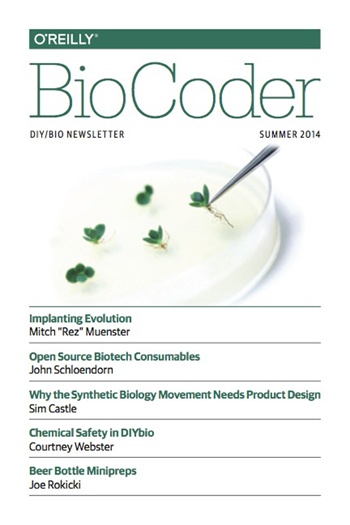
The Summer 2014 edition of BioCoder is now available for free download.
We’ve made it to our fourth issue of BioCoder! I’m excited about this issue — it’s the best collection of articles we’ve published so far.
Some of the highlights are:
- Implanting Evolution:
- We spend a lot of time thinking about how to modify other creatures, from microbes on up. What about ourselves? Surgeons already implant pacemakers and insulin pumps into humans. What about other applications? What are the possibilities if you implant NFC and RFID chips?
- Open Source Biotech Consumables:
- One of the biggest problems for grassroots biotech research is the price of ingredients. Some proteins cost thousands of dollars per milligram, hardly affordable by a community lab or a small startup. We can solve that problem with “open source” DNA. This is an exciting development — and a challenge to what we mean by “open source” (I promise to write about that in another post).

Biology as I/O
Solid's long view includes biology as part of the creator's toolkit.
Tim O’Reilly subjected himself to an engaging Ask Me Anything session on Reddit earlier this week. The focus of the exchange was the Internet of Things, in anticipation of our Solid conference taking place next month.
We’re always listening for faint signals from our community about what they’re getting interested in, and one area that’s stood out to us is biology, which is becoming easier to experiment with at home, as a hobbyist, and through hackerspaces like Biocurious and Genspace. You’ll find a few threads on biology at Solid this year, but we’ve tagged it to be a little more central at Solid 2015. Beyond the hobbyist and health-related applications, we see synthetic biology as another way to translate between virtual and physical, like 3D printers and stereoscopic cameras.
Here’s an exchange from Tuesday’s Reddit thread that sums it up nicely.
What prompted the start of BioCoder? Are people really doing biotech in their garages in the same way that many computer hardware and software innovations happened?
Thanks.

Robots in the lab
Hacking lab equipment to make it programmable is a good first step toward lab automation.
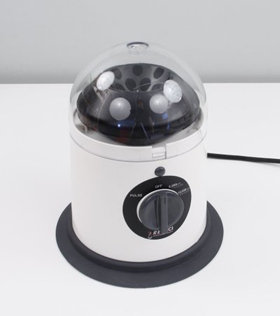
An automated centrifuge at Modular Science — click here for instructions to hack one yourself.
In the new issue of BioCoder, Peter Sand writes about Hacking Lab Equipment. It’s well worth a read: it gives a number of hints about how standard equipment can be modified so that it can be controlled by a program. This is an important trend I’ve been watching on a number of levels, from fully robotic labs to much more modest proposals, like Sand’s, that extend programmability even to hacker spaces and home labs.
In talking to biologists, I’m surprised at how little automation there is in research labs. Automation in industrial labs, the sort that process thousands of blood and urine samples per hour, yes: that exists. But in research labs, undergrads, grad students, and post-docs spend countless hours moving microscopic amounts of liquid from one place to another. Why? It’s not science; it’s just moving stuff around. What a waste of mental energy and creativity.
Lab automation, though, isn’t just about replacing countless hours of tedium with opportunities for creative thought. I once talked to a system administrator who wrote a script for everything, even for only a simple one-liner. (Might have been @yesthattom, I don’t remember.) This practice is based on an important insight: writing a script documents exactly what you did. You don’t have to think about, “oh, did I add the f option on that rm -r / command?”; you can just look. If you need to do the same thing on another system, you can reproduce what you did exactly.

Biomimicry in the real world
There's good reason to believe nature has clues about how to do a good job — can it also help with web designs?

Festo’s Robotic Bird. Photo by Mike Loukides.
A couple of years ago, I visited the World Science Festival in New York and saw Festo’s robotic bird. It was amazing. I’ve seen things that looked more or less like a bird, and that flew, but clearly weren’t flying like a bird. An airplane has a body, has wings, and flies, but you wouldn’t mistake it for a bird. This was different: it looked like a giant seagull, with head and tail movements that were clearly modelled on a living bird’s.
Since then, Festo has built a robotic kangaroo; based on work they started in 2010, they have a robotic elephant’s trunk that learns, a robotic jellyfish, and no doubt many other animals that I haven’t yet seen.

Announcing BioCoder issue 3
Advances in biology and biotechnology are driving us in exciting new directions — be part of the revolution!
We’re excited about the third issue of BioCoder, O’Reilly’s newsletter about the revolution in biology and biotechnology. In the first article of our new issue, Ryan Bethencourt asks the question “What does Biotechnology Want?” Playing with Kevin Kelly’s ideas about how technological development drives human development, Bethencourt asks about the directions in which biotechnology is driving us. We’re looking for a new future with significant advances in agriculture, food, health, environmental protection, and more.
That future will be ours — if we choose to make it. Bethencourt’s argument (and Kelly’s) is that we can’t not choose to make it. Yes, there are plenty of obstacles: the limits to our understanding of biology and genetics, the inadequate tools we have for doing research, the research institutions themselves, and even fear of the future. We’ll overcome these obstacles; indeed, if Bethencourt is right, and biology is our destiny, we have no choice but to overcome these obstacles. The only question is whether you’re part of the revolution or not.
Read more…

